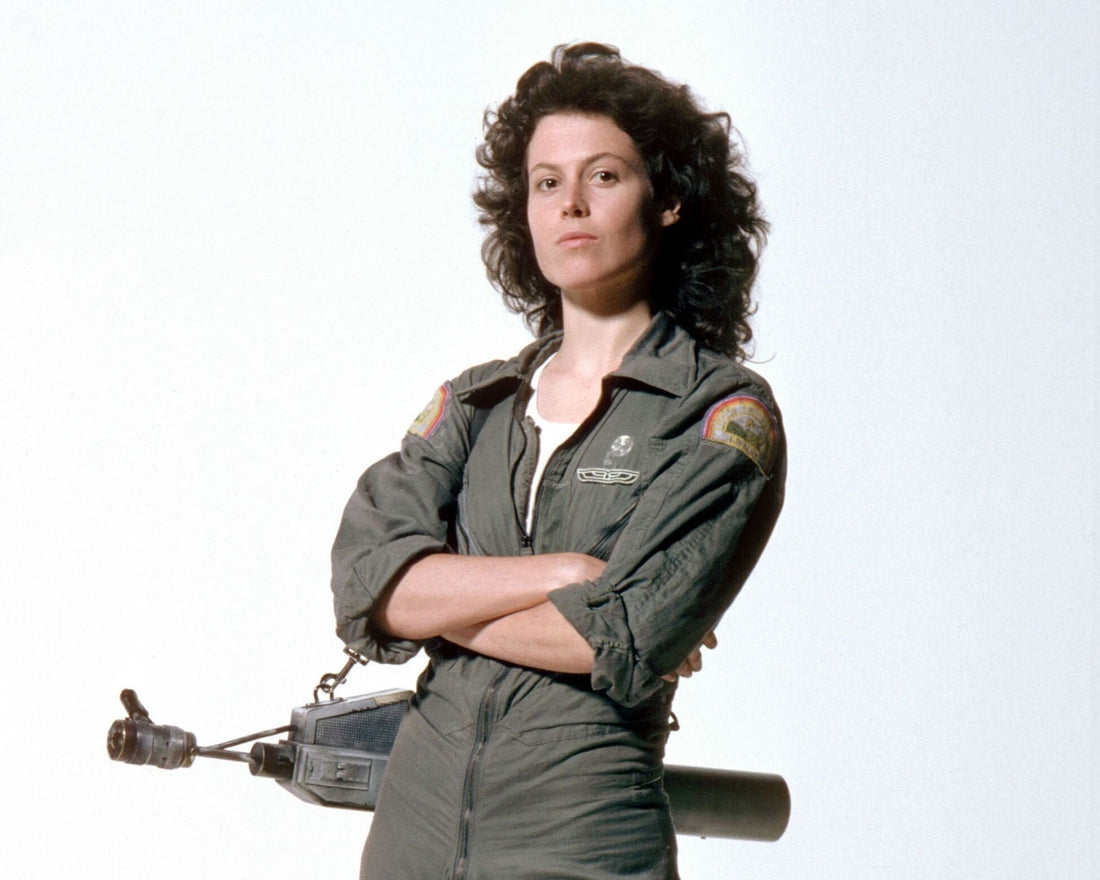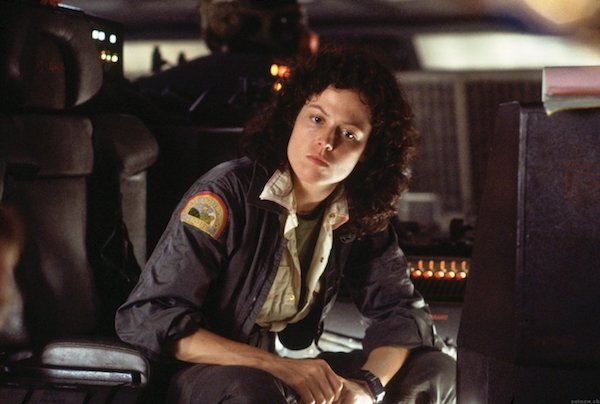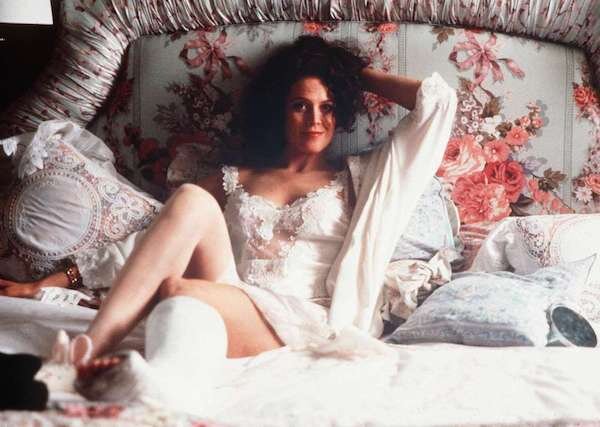Sigourney Weaver changed the face of sci-fi in Alien, but beyond the fictional role the actor played, the way she used her body gave hope to many viewers around the world. On being tall and the patriarchal structures that often make this a burden, Emmy Potter writes a personal ode to Sigourney.
Sigourney Weaver was 29 years old and 6 feet tall when she played Ellen Ripley, first officer of the Nostromo and its sole survivor in the 1979 sci-fi epic Alien. I don’t remember how old I was when I first saw it ( probably not old enough) but I do know I was already taller than all my classmates at school, and more than a little self-conscious about it. A lot of the boys would eventually surpass me by the time we were in high school (as teenage boys seemingly have the ability to grow twice their size overnight like the xenomorphs in Ridley Scott’s movie), but I still felt awkward and out of place. My height and interest in sci-fi movies made me one of the boys, but then put me at odds with my shorter female friends who all had boyfriends who stood shoulder-to-shoulder and saw eye-to-eye with me.
I had already reached my full 5'10" by age 14, and it was always one of the first things people would comment on. “Oh wow, you must play basketball!” (I didn’t) or “How’s the view up there?” (It’s not any different than yours). Sigourney was already 5'10" by age 11, and felt just as self-conscious about her height as me. “I felt like a giant spider,” she once told a reporter, “I never had the confidence to ever think I could act.”
When you’re going through puberty, you can feel like an alien — your body morphing, your desires stirring, your skin alternating between beautiful and grotesque depending on the day and intensity of your hormones — and it’s all you can do to draw as little attention to yourself as possible. And it’s even more difficult when you’re already 5'10" during those early teen years, and have figured out patriarchal structures expect women to take up as little space as possible. I loved my long legs, but part of me desperately wanted to make myself smaller, to blend into my surroundings so I’d be less threatening. My body was beyond my control, but still I tried — contorting myself into what I thought was more desirable and less hostile to the men around me.
Then I watched Alien half a dozen more times, and realized the minute Ripley takes command of the ship, the men treat her with as much hostility as they do the creature hunting them down. Their problem isn’t her height or body, but her gender and authority. In this way, Sigourney’s height in the film is used as an asset rather than a liability — it makes her stand out but it also gives her a power I’d never noticed until I really started paying closer attention. She owns herself completely without apology, which makes the film’s conflict even stronger. As Ripley grows more confident in her leadership abilities, Sigourney draws herself up to her full height, making her presence all the more commanding and far more formidable to the alien onboard.
Many male actors are frequently lavished with praise for their physical transformations — from Marlon Brando in A Streetcar Named Desire to Chris Hemsworth as Thor. Whole screeds have been written about method actors like Christian Bale and Daniel Day-Lewis putting their bodies through extremes, for the sake of art, and so we the audience have an easier time believing them to be heroes or villains. For women onscreen, physical transformations tend to be either about obscuring beauty (Nicole Kidman’s nose in The Hours or Charlize Theron’s entire face in Monster) or re-shaping our bodies to look harder, more stereotypically masculine (Linda Hamilton in Terminator 2 or Hilary Swank in Million Dollar Baby) . Yet both of these types of female physical transformation are ultimately still defined by, and appeal to, the male gaze.
Far less heralded are the performances in which subtle physical transformations happen from the inside out — where a character changes psychologically and emotionally and thus their behaviour changes. The character sees their body differently and as a result, so does the audience. The transformation relies on acceptance of pre-determined imaginary circumstances — to borrow a term from Stanislavski-based acting training — rather than extreme external physical manipulation. The physical is the result of the psychological, and when this occurs, the body becomes a tool the actor uses instead of the other way around. By the end of Alien, Ripley has the body of a hero not because she suddenly has bigger muscles, but because of Sigourney Weaver’s understanding of Ripley’s emotional life, which she conveys through her actions and physical presence throughout the film. Her body — all 6 feet of it — is what it is, and because she accepts it an, given the imaginary circumstances, we do too.
It’s not news that the process of accepting your body is difficult as a teenager or even a young adult — especially if you’re a woman. We’re supposed to be locked in a constant battle with ourselves, which keeps us distracted, which often allows men to continue running the show with full impunity. I spent so much time unhappily trying to shrink myself in my teen years – wearing flats, hunching my shoulders, poking at my little tummy in dressing room mirrors, covering up acne with too much makeup – when I could have been running the Nostromo that is high school if I’d just accepted my body the way Sigourney Weaver does. What I understand now in my thirties is that a woman who accepts herself is always seen as a threat, because it gives her freedom and power independent from the men around her. Acceptance is ownership and autonomy. Acceptance is a kind of confidence.
Confidence is key to Weaver’s performance as imperious Wall Street executive Katharine Parker in Working Girl . On the surface, Katharine exudes a kind of sophisticated elegance, placing her in sharp contrast with Melanie Griffith’s working-class Staten Island secretary Tess McGill. Weaver again plays up her height through posture and presence alone, which makes it feel as though she’s really lording it over Tess even though Griffith is only really a couple of inches shorter. There’s a Joan Crawford-esque energy to her performance — all broad-shouldered confidence and sexuality, with a glimmer of something harder underneath. Katharine is a boss in every sense of the word, and Weaver makes sure she takes up as much space as possible every time she’s onscreen.The actor understands that Katharine uses her body to seduce and destroy — the gender of her target is immaterial. To seduce Tess, Katharine offers handshakes and big smiles, promising their working relationship will be an egalitarian one despite their different job titles. With men like Harrison Ford’s Jack Trainer, she’s all hands and bedroom eyes, unwilling to take no for answer in the boardroom or bedroom. In both cases, Weaver’s body language is clear, confident, and no-nonsense. It’s also hilarious — this is a romantic comedy after all — and light-years away from her physical work in the Alien movies.
Still, there’s a transformative quality to Weaver’s physical life in Working Girl too. She takes the viewer on the journey of an overly confident woman whose deep insecurities are laid bare by the film’s end — the posture is slighter, hands curled in anxiety, arms gesticulating wildly rather than gracefully. It’s a stark change from the tall, elegant Katharine Parker we met at the beginning of the film. All of this is only possible because Weaver herself works with confidence even when her character has lost most, if not all, of hers.
Like Weaver, I went to college for theatre. I landed a few small supporting roles early on, but there were more rejections for me during my four years at school than parts I got to play. I had the face of an ingenue and was hungry to prove myself, but once again, my height was a problem. I was taller than most other young women and more than a few of the guys at my school, which nixed me almost immediately from playing romantic parts and lots of similar lead roles, even though I knew I had the skills for them. Casting ( already an undemocratic process) in academic settings is naturally skewed, given the talent pool is just a crop of eager twenty-somethings and not a wide range of ages (or even types), but it undermines any sense of self you have during an emotionally fraught period where you’re desperately trying to establish it.
“I’m a weird duck, because I was never a ‘girlfriend,’” Weaver told The Guardian in 2016, “I was always too tall to be the girlfriend. So I didn’t have to say goodbye to my sexual self and hello to my executive self. I’ve always played interesting people.” I’ve never played the girlfriend either — not in school and not in the real world. In my senior year, I finally got a lead role — playing a mother in her forties. I was 22, but at 5'10", I could read as older onstage to the 5'4", also 22-year-old, actress playing my daughter. It was a meaty part that I am still — nearly ten years later — too young to play, but at least it was more interesting than being someone’s love interest. I graduated from college not knowing fully who I was onstage or off, but I did know I would no longer limit myself because of my height – even if other people wanted to. Seeing Sigourney Weaver onscreen during those formative years of my life gave me confidence to accept my body — all 5'10" of it — and that’s when my own transformation began from the inside out.
I wish I could go back and tell my younger self to stand up for herself a little more — to not be afraid of taking up space. I’d tell her that being herself is better than being adored. I’d tell her that her body is not some hostile alien to be feared and destroyed, but one of a heroine .
“When I was younger,” Sigourney once said, “my mother always said I might not enjoy my height now, but someday I’ll be glad.”
Today, I’m glad.
Emmy Potter (@emmylanepotter) is a New York-based writer and actor whose work has appeared in Bright Wall/Dark Room, Consequence of Sound, IFC, and CultureSonar (among other outlets). She holds a B.M. in Music Theatre from Oklahoma City University.



